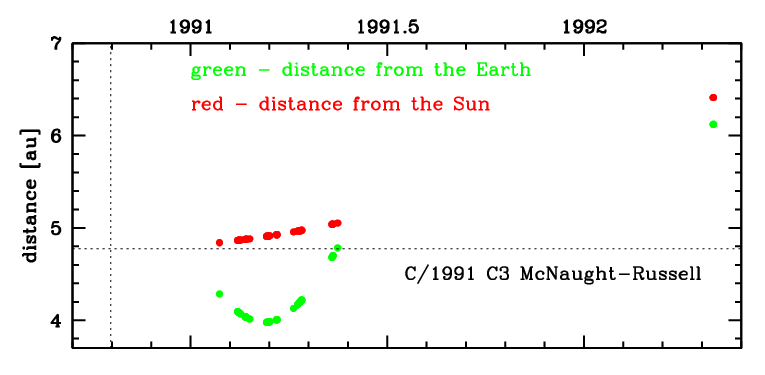C/1991 C3 McNaught-Russell
more info
Comet C/1991 C3 was discovered on 12 February 1991 by Robert H. McNaught and Kenneth S. Russell with U> Schmidt at Siding Spring [IAUC 5187, February 13], almost four months after perihelion passage; however, two days later the prediscovery observation taken on 26 January was found [IAUC 5189, 15 Feb].
The comet was observed 1.3 yr in a range of heliocentric distances from 4.84 au to 6.41 au with almost one-year gap between 16 May 1991 and 30 April 1992.
C/1991 C3 made its closest approach to the Earth on 11 March 1991 (3.98 au), that was one month after its discovery.
This comet suffers strong planetary perturbations during its passage through the planetary system that lead to notable more tight future orbit with semimajor axis shorter than 1000 au (see future barycentric orbit).
See also Królikowska and Dybczyński 2017.
The comet was observed 1.3 yr in a range of heliocentric distances from 4.84 au to 6.41 au with almost one-year gap between 16 May 1991 and 30 April 1992.
C/1991 C3 made its closest approach to the Earth on 11 March 1991 (3.98 au), that was one month after its discovery.
This comet suffers strong planetary perturbations during its passage through the planetary system that lead to notable more tight future orbit with semimajor axis shorter than 1000 au (see future barycentric orbit).
See also Królikowska and Dybczyński 2017.
| solution description | ||
|---|---|---|
| number of observations | 42 | |
| data interval | 1991 01 26 – 1992 04 30 | |
| data type | observed only after perihelion (POST) | |
| data arc selection | entire data set (STD) | |
| range of heliocentric distances | 4.84 au – 6.41au | |
| detectability of NG effects in the comet's motion | NG effects not determinable | |
| type of model of motion | GR - gravitational orbit | |
| data weighting | NO | |
| number of residuals | 82 | |
| RMS [arcseconds] | 0.96 | |
| orbit quality class | 1b | |
| orbital elements (heliocentric ecliptic J2000) | ||
|---|---|---|
| Epoch | 1990 11 05 | |
| perihelion date | 1990 10 18.19724910 | ± 0.00924786 |
| perihelion distance [au] | 4.77707372 | ± 0.00005293 |
| eccentricity | 1.00174603 | ± 0.00010724 |
| argument of perihelion [°] | 320.886310 | ± 0.001085 |
| ascending node [°] | 161.709637 | ± 0.000174 |
| inclination [°] | 113.430375 | ± 0.000389 |
| reciprocal semi-major axis [10-6 au-1] | -365.50 | ± 22.44 |
